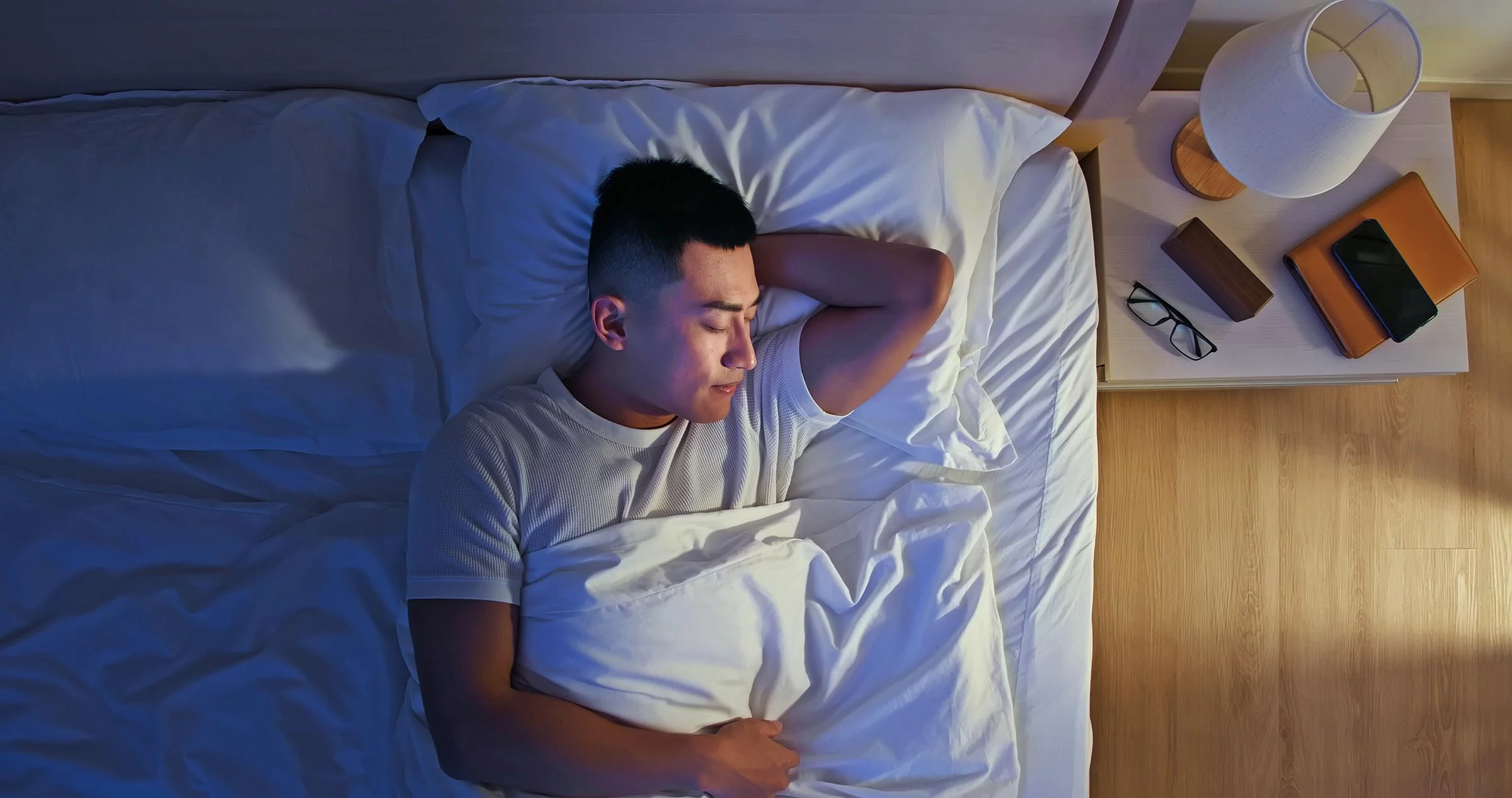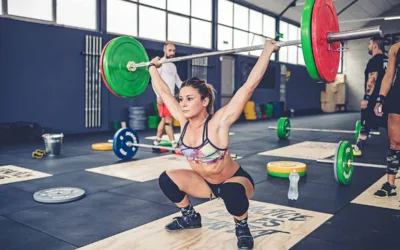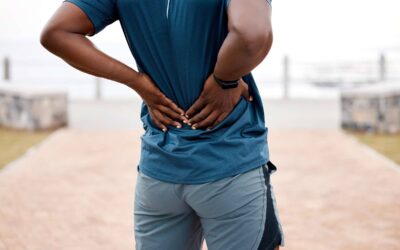Optimize Your Sleep Hygiene for Peak Performance
TOPIC: Recovery
Every rep, every mile, every drop of sweat, it all counts. But if you’re not prioritizing sleep, you’re sabotaging your own progress. Here’s how to turn your nights into your biggest performance edge.

Written By
Lily Frei
Lily is TrainHeroic’s Marketing Content Creator and a CF-L1 — she was a successful freelance marketer for the functional fitness industry until being scooped up by TrainHeroic. An uncommon combo of bookish, artsy word-nerd and lifelong athlete, Lily is passionately devoted to weightlifting, CrossFit, yoga, dance, and aerial acrobatics.
Insta
Sleep Like a Pro: How to Optimize Rest for Peak Recovery
Sleep is the ultimate recovery tool. Forget the ice baths, the massage guns, the compression sleeves—none of it matters if you’re not logging quality sleep. You can lift hard, train smart, and eat like a dietitian’s dream, but if your sleep is trash, your gains will be too.
Athletes especially need to treat sleep like part of their training plan. This is when your muscles repair, your nervous system resets, and your body consolidates all the adaptations you’ve been grinding for in the gym or on the field. So let’s get into what “optimizing sleep” really means—and how to do it consistently.
Why Sleep Matters for Athletes
When you sleep, your body releases growth hormone, ramps up protein synthesis, and balances key hormones like cortisol (stress) and testosterone (recovery and performance). Your brain also clears out metabolic waste that builds up during the day, which keeps your mind sharp for training, tactics, and decision-making.
For athletes, skimping on sleep doesn’t just mean dragging through practice—it can increase injury risk, stall muscle growth, and wreck reaction time. One Stanford study found that basketball players who added extra sleep improved sprint times and shooting accuracy. Another showed that sleep-deprived athletes had a much higher chance of injury compared to their well-rested teammates.
Bottom line: sleep is performance fuel.
Building Your Sleep Hygiene Game
“Sleep hygiene” is the fancy way of saying: set your environment and habits up so sleep happens easily and deeply. Here are the big hitters:
1. Keep It Dark and Cool
Your body naturally wants to sleep when it’s dark. Blackout curtains, a good eye mask, or even a cheap roll of blackout film on your windows can be game changers.
Temperature is just as important—cooler rooms help trigger your body’s drop in core temperature that signals it’s time to sleep. Aim for 60–67°F (15–19°C). If you’re sweating under the sheets, you’re fighting biology.
2. No TVs, No Phones, No Scroll Holes
That pre-bed “just one more scroll” is wrecking your sleep. Blue light from screens suppresses melatonin, the hormone that helps you fall asleep. Beyond that, the dopamine hit of TikTok or late-night emails keeps your brain wired.
Instead: set a cutoff. One hour before bed, no screens. If you must, use blue light blocking glasses or “night mode,” but the real win is unplugging.
3. Consistency is King
Going to bed and waking up at the same time trains your circadian rhythm like clockwork. If you’re constantly shifting your sleep schedule, your body never finds its groove. Think of it like training: you wouldn’t change your workout time every single day and expect peak results.
4. Timing Your Fuel
Late-night snacking can feel harmless, but digestion is work—and your body should be winding down, not clocking in for overtime. Heavy meals, especially carb-heavy or fatty foods, can mess with sleep quality and even lead to acid reflux when you lie down.
Give yourself 2–3 hours between your last meal and bedtime. If you’re genuinely hungry, go light: something like a small protein shake or a few bites of Greek yogurt. Enough to take the edge off, not a feast.

Tools of the Trade: Sleep Aids Worth Trying
Here’s where things get interesting. Beyond environment and habits, there are a few safe and popular tools athletes are using to push their sleep game up a notch.
Mouth Tape
Sounds weird, works wonders. Mouth taping encourages nasal breathing, which improves oxygenation, reduces snoring, and helps keep you in deeper sleep stages. Use specialized sleep tape (not duct tape, please). If you struggle with congestion, try a nasal strip first.
Eye Masks & Ear Plugs
Eye masks block any stray light (think streetlamps or early sun). Ear plugs can be clutch if you live in a noisy area. Both are cheap, simple hacks that instantly improve sleep quality.
Magnesium
Magnesium plays a role in over 300 bodily processes, including relaxation and muscle recovery. Many athletes are deficient, and supplementing can help calm the nervous system and support deeper sleep. The most popular forms for sleep are magnesium glycinate or magnesium threonate (avoid magnesium oxide—it’s poorly absorbed).
CBD
CBD (cannabidiol) is a non-psychoactive compound from hemp that can help with relaxation and anxiety. Some athletes find it helps quiet the mind before bed. Look for third-party tested products to ensure you’re getting quality CBD without THC contamination.
Melatonin
Melatonin can be useful, but treat it like a tool, not a daily crutch. It’s most effective when your schedule is disrupted—like after late games, travel, or jet lag. Low doses (0.3–1mg) are typically better than the mega-doses sold in stores, since too much can actually backfire.
Other Popular Hacks
- White Noise Machines: Block out sudden sounds that can jolt you awake. Great if you live in the city.
- Weighted Blankets: The gentle pressure can calm the nervous system and help you fall asleep faster.
- Pre-Bed Routine: Stretching, foam rolling, journaling, or breathwork can cue your body it’s time to chill. Even brushing your teeth at the same time nightly acts as a trigger.
- No Afternoon Caffeine: Caffeine has a half-life of about 6 hours. That “harmless” 4pm cold brew? It’s still in your system at 10pm.
Putting It All Together
Think of sleep optimization as a layered system. Start with the foundations—dark, cool room, consistent schedule, no screens. Add timing tweaks—no big meals or caffeine close to bedtime. Then experiment with tools like magnesium or CBD if you need the extra edge.
The trick isn’t to try everything at once, but to test what actually helps you. Athletes track their workouts, nutrition, even their heart rate variability. Why not track your sleep quality too? Wearables like WHOOP, Oura, or even simple sleep journals can help you see what works.
Final Thoughts
Here’s the truth: there’s no magic pill. But when you put sleep at the top of your recovery hierarchy, everything else gets easier—muscle growth, fat loss, energy, mental focus, injury prevention. It’s the most underrated performance enhancer on the planet.
So tonight, do yourself a favor. Shut down the screens, make your room a sleep cave, and give your body the full recovery window it deserves. You’ll wake up stronger for it.
Find Your Perfect Training Plan
Sometimes all you need to reach your destination on your fitness journey is an expert guide. Look no further, we've got you covered. Browse from thousands of programs for any goal and every type of athlete.
Try any programming subscription FREE for 7 days!
Related Articles
You May Also Like...
3 Ways to Improve Mobility Without Stretching
Are you still trying the endless foam rolling and stretching exercises to get that deep squat position? We know how important mobility is for great, or even GOOD performance. All professional athletes have some comfortability in end ranges of motion. So, what else do...
Active Recovery Strategies for Strength Athletes
Active recovery isn’t just about taking it easy—it’s a smart way to keep your body moving, boost circulation, and enhance performance without adding fatigue. While passive recovery has its place, low-intensity movement between sessions helps reduce stiffness and...
The Ultimate Low Back Training Guide: Tips for a Stronger Spine
Low back pain sidelines countless athletes and gym-goers. But here’s the truth: your lower back doesn’t need endless isolation work to stay strong. The real secret? A smart mix of direct and indirect training strategies. This guide breaks it all down, giving you...
3 Ways to Improve Mobility Without Stretching
Are you still trying the endless foam rolling and stretching exercises to get that deep squat position? We know how important mobility is for great, or even GOOD performance. All professional athletes have some comfortability in end ranges of motion. So, what else do...
Active Recovery Strategies for Strength Athletes
Active recovery isn’t just about taking it easy—it’s a smart way to keep your body moving, boost circulation, and enhance performance without adding fatigue. While passive recovery has its place, low-intensity movement between sessions helps reduce stiffness and...

Want more training content?
Subscribe
For Coaches
For Athletes
About
Support
Training Lab
Access the latest articles, reviews, and case studies from the top strength and conditioning minds in the TH Training Lab!
Made with love, sweat, protein isolate and hard work in Denver, CO
© 2024 TrainHeroic, Inc. All rights reserved.





